Step 4.3.6 - Installation of SDI
Step 4.3.6 - Installation of SDI
SDI system suppliers can design the system and help with the selection and installation of the various components. It is important to make sure that the designer visits the site to familiarise themselves with its features. You should talk to other farmers using SDI in your area to learn from their experience and also discuss your plans with service providers and with DPI staff. A poor design, inappropriate selection of system components or substandard installation will reduce efficiency and/or increase cost of the system. The installation should be done well before planting so that the site can settle evenly. Care is essential with the installation. The location of all components needs to be accurately delineated on maps and in the field. Before installation of drip tape, the soil needs to be prepared by ripping to the root depth. Cross-ripping will promote the movement of water laterally from the drip tape.
An outline of the installation of SDI is described below
| Select the site where you want to install the system. Construct the right size pump shed from where the system will be operated. An existing shed on the site can also be used. | 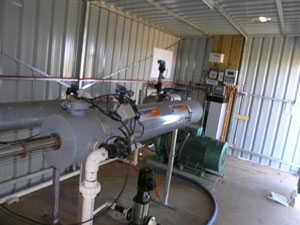 |
| Install the main line from source of water to the shed. | 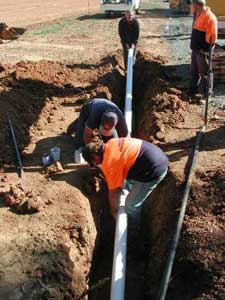 |
| The sub-mains are installed at the upstream and down stream ends of the field. Normally the trench should be 1.0-1.5 m wider than the main and sub-main so that the pipe can be installed easily and accurately. The depth of the sub-main and flushing manifold is deeper than the drip tape in order to minimise debris entering the tapes and allow for proper flushing of the system. | 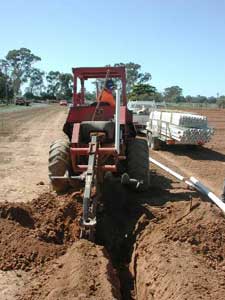 |
The installation of the drip tape is the next step. The drip tapes pass through injectors which install the tape to the required depth and spacing. A GPS unit on the tractor ensures correct alignment. The depth and spacing of the installed tape should be checked periodically as it is laid to assure correct placement. The emitter opening should be toward the top so that the emitter blocking can be minimised.
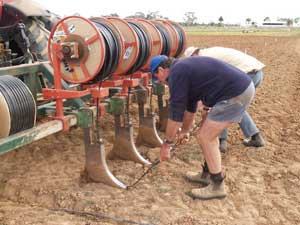 | 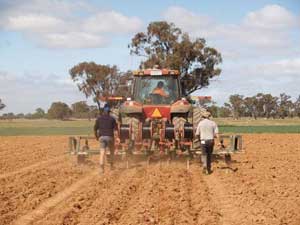 |
| The drip tapes are then joined to the sub-mains via connectors (supply tubes) and other equipment associated with the sub-mains, such as air release valves, flow meters, flush valves, and automation. The downstream sub-main will require air release and flush valves. Ensure all joints are well made because loose or weak joints will be problematic when the main and sub-main are buried and it becomes hard to detect and repair leaks.. | 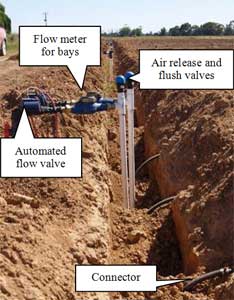 |
- Check the filters and back flush them manually
- Make sure the pressure reducing valve is adjusted to the desired pressure as recommended for the design
- Run the system in manual and auto mode, and check for leaks and that all components are working properly. If there is any leakage, shut down and repair the system
- Flush the system and once the system is flushed close the flushing valves
- Check the system also works properly on auto mode
- Attach fertiliser unit with the system and test it for manual and auto mode
- Bury the main and sub-main
- Allow time for the earthworks to settle before crop establishment
- Initiate your regular maintenance schedule
References
Allen, R. G., Pereira. L. S., Raes. D., & Smith. M. (1998). Crop evapotranspiration: guidelines for computing crop water requirements. FAO Irrigation and Drainage Paper 56.
Australian Greenhouse Office. (2004). Factors and methods workbook. Version 4. Australian Greenhouse Office, Canberra.
Brook, P. (2007). Is subsurface drip irrigation suited to the Murray region? Irrigation Research and Extension Committee (IREC) Farmers Newsletter. 175. Autumn 2007
Dassanayake K., R. Wrigley., & D, Chapman. (2009). Sub-surface drip irrigated annual and perennial forage systems for raising the economic productivity of the Northern Victorian dairy industry. Paper presented to Irrigation Australia Conference, Swan Hill Victoria, 18-21 October.
DPI (2006). Water salinity tolerance of different crops and stock in the Shepparton irrigation region. Department of Primary Industries, Ferguson Road Tatura Victoria.
Hanson, B., & May, D. (2004). Effect of subsurface drip irrigation on processing tomato yield, water table depth, soil salinity, and profitability. Agricultural Water Management, 68, 1-17.
Heard, J., & Finger, L. (2009). Modelling dairy farming systems. Subsurface drip irrigation in pasture production-does it pay?: Future farming systems research division. Department of Primary Industries. Victoria.
Jackson, T. (2009) An appraisal of the on-farm water and energy nexus in irrigated agriculture. PhD thesis submitted to Charles Sturt University, March 2009.
Pitts, D. J., Haman, D. Z., & Smajstrla, A. G. (1990). Causes and prevention of emitter plugging in microirrigation systems. Bulletin No. 258. Florida Cooperative Extension Service, Institute of Food and Agricultural Sciences, University of Florida.
Reich, D., Godin, R., Chavez, J.L., & Broner, I. (2009). Subsurface Drip Irrigation. Crop Series No. 4.716. Colorado State University Extension.
Yiasoumi, B. (2003). Selecting an irrigation pump. Agfact E5.8. 3rd Ed. NSW Agriculture.
Further Reading
Burt, C. M. (2006). Surface drip tape irrigation systems as an alternative to subsurface drip irrigation (SSD) for field and row crops. Paper presented at the Seventh Micro Irrigation Congress, 13-15 September, Kuala Lumpur, Malaysia.
Burt, C. M., & Styles, S. W. (2007). Drip and micro irrigation for trees, vines, and row crops: design and management for trees, wines and field cops: (Third ed.): Poor Richards Press, San Luis Obispo, California.
Grabow, G. L. K., Harrison, K., Smith, W. B., Vories, E., Zhu, H., & Khalilian, A. (2005). Design of subsurface drip irrigation systems in humid areas. Paper presented at the 2005 World Water and Environmental Resources Congress, May 15-19, Anchorage, AK.
Enciso, J., Porter, D., Bordovsky, J., & Fipps, G. (2004). Maintaining subsurface drip irrigation systems. Publication No. L-5406. Texas Cooperative Extension. The Texas A & M University System .
Harris, G. A. (2005). Sub-surface drip irrigation - system components. Note No. 17654. DPI&F, QLD.
Harris, G. A. (2005). Sub-surface drip irrigation - system design. Note No. 17652. DPI&F, QLD.
Harris, G. A. (2005). Sub-surface drip irrigation - system maintenance. Note No. 17653. DPI&F, QLD.
IFIA (2009). Fertilizers, climate change and enhancing agricultural productivity sustainably. International Fertiliser Industry Association (IFIA). First Edition. Paris, France.
Lamm, F. R., Rogers, D. H. Alam. M., & Clark, G. A. (2003). Design considerations for subsurface drip irrigation (SDI) Systems. Irrigation Management Series. Kansas State University Agricultural Experiment Station and Cooperative Extension Service Manhattan, Kansas.
Michael, A. M. (1999). Irrigation theory and practice: Vikas publishing house, New Delhi, India.
Raine, S. R., Foley, J. P., & Henkel, C. (2000). Drip irrigation in the Australian cotton industry: a scoping study. National Centre for Engineering in Agriculture. Publication No. 179757/1, USQ, Toowoomba.
Schwab, G. O., Fangmeier, D. M., Elliot, W. J., & Frevert, R. K. (1993). Soil and water conservation engineering (Fourth ed.): John Willey and Sons, USA.
Stryker, J. (2009). The basic parts of the drip system. Retrieved 5 October 2009.
Thorburn, P., Biggs, J., Bristow, K., Horan, H., and Huth, N. (2003). Benefits of sub-surface application of nitrogen and water to trickle irrigated sugarcane. Proceedings of the 11th Australian Agronomy Conference, 2-6 Feb. 2003, Geelong, Victoria
Watson, J., & Knowles, T. (1999). Leaching for maintenance. Factors to consider for determining the leaching requirement for crops. Arizona Water Series Number 22. The University of Arizona, College of Agriculture Tucson.


